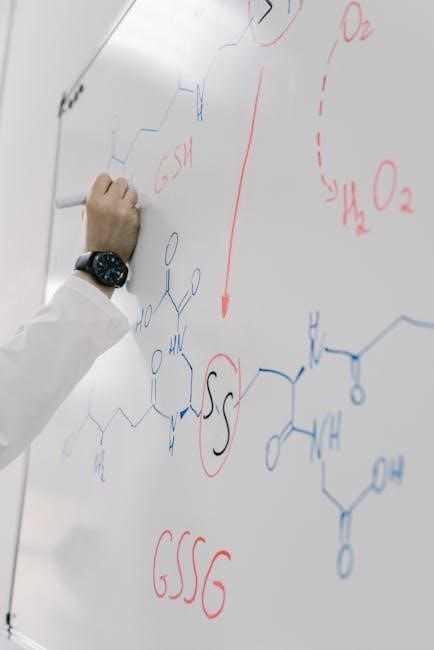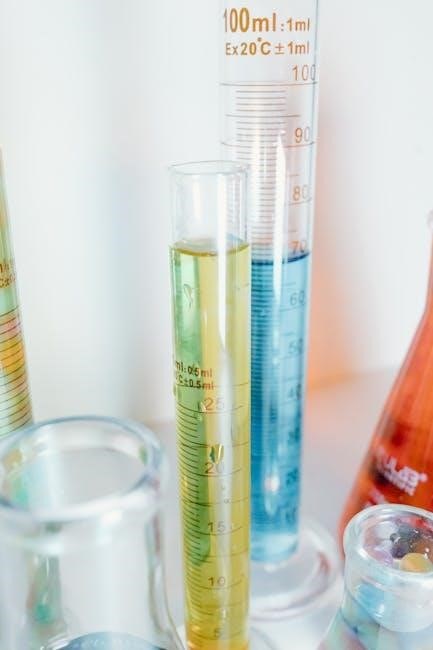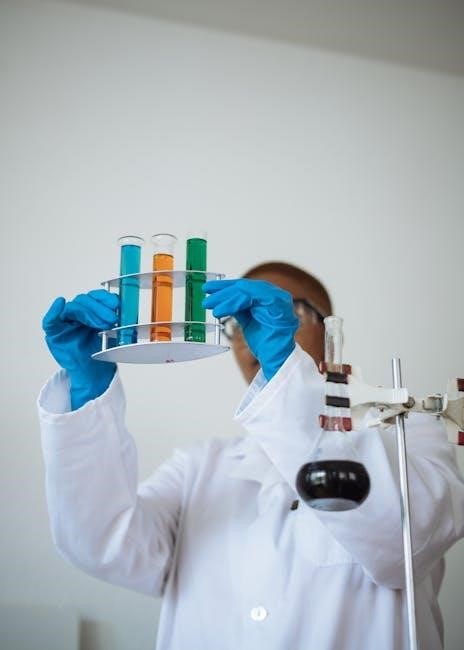
A reaction mechanism outlines the step-by-step pathway of a chemical reaction, detailing the transformation of reactants into products through intermediates and transition states․ Understanding mechanisms is crucial for predicting reaction outcomes, optimizing conditions, and designing synthetic strategies in organic chemistry․
1․1 Definition and Importance of Reaction Mechanisms
A reaction mechanism is a detailed, step-by-step explanation of how reactants are transformed into products, including the formation of intermediates and transition states․ It provides insights into the sequence of bond-breaking and bond-forming processes, helping chemists understand the molecular logic behind reactions․ The importance of reaction mechanisms lies in their ability to predict reaction outcomes, optimize conditions, and guide the design of new synthetic pathways․ By understanding mechanisms, chemists can also explain the influence of factors like stereochemistry, solvent effects, and catalysis on reaction efficiency and selectivity․
1․2 Brief Overview of Organic Chemistry Fundamentals
Organic chemistry focuses on carbon-containing compounds, exploring their structures, properties, and reactions․ Key concepts include functional groups, which determine a molecule’s reactivity, and stereochemistry, which influences reaction outcomes․ Understanding the behavior of electrons, such as nucleophilicity and electrophilicity, is central to predicting reaction mechanisms․ Additionally, principles like acid-base chemistry and thermodynamics guide the analysis of reaction feasibility and pathways․ These fundamentals form the foundation for studying complex organic reactions, enabling the design of efficient synthetic methods and the development of new materials and drugs․

Types of Reaction Mechanisms
Organic reaction mechanisms are categorized into substitution, addition, elimination, and rearrangement reactions, each with distinct pathways and significance in understanding chemical transformations․
2․1 Substitution Reactions (SN1, SN2)
Substitution reactions involve the replacement of a leaving group with a nucleophile․ SN1 mechanisms proceed via a two-step process, forming a carbocation intermediate, while SN2 reactions occur in a single concerted step with a backside nucleophilic attack․ SN1 favors tertiary substrates due to stable carbocations, whereas SN2 prefers primary substrates for steric reasons․ The choice of solvent and leaving group significantly influences the reaction pathway․ These mechanisms are fundamental in understanding nucleophilic substitution and its applications in organic synthesis․
2․2 Addition Reactions (Electrophilic and Nucleophilic)
Addition reactions involve the combination of two or more reactants to form a single product․ Electrophilic addition reactions, such as those of alkenes with acids, occur when an electrophile attacks the electron-rich π-bond․ Nucleophilic addition, seen in carbonyl compounds, involves a nucleophile attacking an electron-deficient carbonyl carbon․ These reactions are crucial in organic synthesis, enabling the formation of complex molecules․ The mechanism often depends on the substrate’s structure and reaction conditions, making understanding these pathways essential for controlling reaction outcomes and designing new synthetic strategies․
2․3 Elimination Reactions (E1, E2, E1cB)
Elimination reactions involve the removal of atoms or groups from adjacent atoms, forming a double bond․ E1 mechanisms proceed via a carbocation intermediate, where deprotonation follows after the leaving group departs․ E2 mechanisms involve a concerted process with a single transition state, requiring anti-periplanar geometry․ E1cB mechanisms occur under basic conditions, where deprotonation forms a carbanion intermediate before the leaving group departs․ Each mechanism’s pathway depends on the substrate and reaction conditions, such as solvent and base strength, making understanding these distinctions critical for predicting and controlling reaction outcomes in organic synthesis․

2․4 Rearrangement Reactions (Hydride and Alkyl Shifts)
Rearrangement reactions involve the migration of atoms or groups within a molecule, leading to structural isomerism․ Hydride shifts involve the transfer of a hydrogen atom with its bonding electrons, while alkyl shifts involve the migration of an alkyl group․ These shifts often occur in carbocation intermediates to stabilize the charge, forming more stable carbocations․ The mechanism typically involves a concerted process where the migrating group moves simultaneously with the departure of a leaving group or the formation of a double bond․ Rearrangement reactions are pivotal in understanding pathways for carbocation stability and product distribution in organic synthesis․

Key Concepts in Reaction Mechanisms
Understanding reaction mechanisms involves concepts like stereochemistry, electron distribution, and transition states․ These principles explain how reactants transform into products through intermediate steps, guiding synthetic strategies․
3․1 Stereochemistry and Its Role in Mechanisms
Stereochemistry plays a pivotal role in organic reaction mechanisms by influencing the spatial arrangement of atoms․ The three-dimensional structure of molecules determines the approach of reactants, affecting reaction pathways and product formation․ For instance, in substitution reactions like SN1 and SN2, stereochemistry dictates whether racemization or inversion occurs․ Similarly, in addition reactions, the stereochemical outcome depends on the geometry of the starting materials and intermediates․ Understanding stereochemical principles is essential for predicting reaction outcomes and designing efficient synthetic routes in organic chemistry․
3․2 Inductive Effect and Its Influence on Reactivity
The inductive effect refers to the electron-withdrawing or electron-releasing properties of substituents transmitted through sigma bonds․ Electron-withdrawing groups (-I effect) reduce electron density, while electron-releasing groups (+I effect) increase it․ This effect significantly influences reaction mechanisms by altering the reactivity of molecules․ For example, electron-withdrawing groups activate certain positions for electrophilic substitution and stabilize transition states in elimination reactions․ Conversely, electron-releasing groups can deactivate molecules or direct reactions to specific sites․ Understanding the inductive effect is crucial for predicting reaction pathways and controlling selectivity in organic synthesis․
3․3 Resonance and Delocalization of Electrons
Resonance and electron delocalization are fundamental concepts in understanding organic reaction mechanisms․ Resonance structures depict the redistribution of electrons in molecules, illustrating how electrons can delocalize to stabilize intermediates, such as carbocations or enolates․ This delocalization lowers energy barriers and influences reaction pathways․ For instance, in aromatic compounds, electron delocalization enhances stability, while in conjugated systems, it facilitates charge distribution․ Recognizing resonance structures and delocalization patterns is essential for predicting regioselectivity, stereochemistry, and the feasibility of reaction mechanisms․ This concept is pivotal in designing synthetic strategies and interpreting reaction outcomes in organic chemistry․

Energy Profiles and Transition States
Energy profiles illustrate the energy changes during reactions, showing reactants, products, and the transition state․ Transition states represent the highest energy point, influencing reaction rates and pathways․

4․1 Activation Energy and Reaction Pathways
Activation energy is the minimum energy required for reactants to form products․ Lower activation energy implies a faster reaction․ Reaction pathways describe the sequence of steps, including intermediates and transition states․ Catalysts reduce activation energy by providing alternative pathways․ Understanding these concepts helps predict reaction efficiency and optimize conditions․ Energy profiles visualize this, showing peaks at transition states․ These insights are vital in organic synthesis, enabling chemists to design efficient processes and control reaction outcomes effectively․
4․2 Transition State Theory and Its Application
Transition state theory (TST) explains the highest energy state during a reaction, serving as the gateway between reactants and products․ It provides a framework to predict reaction rates and mechanisms․ TST applications include understanding stereoselectivity, catalysis, and reaction pathways․ By identifying transition states, chemists can design reactions with improved efficiency and specificity․ This theory is foundational in modern organic chemistry, aiding in the development of new synthetic methods and catalytic systems․ Its principles are widely applied in drug design and materials science, highlighting its significance in advancing chemical research and industrial processes․

Free Radical Reactions
Free radical reactions involve highly reactive intermediates with unpaired electrons, driving processes like addition, elimination, and polymerization․ Initiation, propagation, and termination steps define their mechanisms․
5․1 Initiation, Propagation, and Termination Steps
Free radical reactions proceed through three distinct phases: initiation, propagation, and termination․ Initiation involves the creation of radicals, often through bond homolysis or exposure to light/heat․ For example, in halogenation, Cl₂ splits into two Cl• radicals․ Propagation occurs when radicals react with molecules, forming new radicals and sustaining the chain reaction․ This step is key for product formation, such as adding Cl• to alkanes․ Finally, termination halts the reaction when radicals combine or are neutralized, ending the chain․ These steps are fundamental to understanding mechanisms in organic chemistry, enabling precise control over reaction outcomes and efficiency․
5․2 Examples of Free Radical Mechanisms
Free radical mechanisms are prevalent in various organic reactions․ One classic example is the halogenation of alkanes, where radicals facilitate the substitution of hydrogen with halogens․ Another notable instance is the polymerization of ethylene, driven by radical initiators․ Additionally, oxidation reactions, such as the autoxidation of fats, proceed via radical pathways, leading to the formation of peroxides․ These examples illustrate the versatility of free radical mechanisms in organic chemistry, highlighting their role in both synthesis and degradation processes․ Understanding these mechanisms is essential for controlling reaction outcomes and developing new materials․

Solvent Effects on Reaction Mechanisms
Solvent effects significantly influence organic reaction mechanisms by stabilizing charges, altering transition states, and modulating reaction rates․ Polar solvents enhance ionic interactions, while nonpolar solvents favor hydrophobic interactions, impacting reaction pathways and efficiency․
6․1 Polar Protic vs․ Polar Aprotic Solvents
Polar protic solvents, such as water and alcohols, can donate hydrogen bonds, stabilizing charged species and influencing reaction mechanisms․ Polar aprotic solvents, like DMF and DMSO, lack hydrogen bonding ability but solvate ions through dipole interactions․ Protic solvents favor SN1 reactions by stabilizing carbocations, while aprotic solvents enhance SN2 mechanisms by loosening the solvent shell around nucleophiles․ This solvation effect significantly impacts reaction rates and pathways, making solvent choice critical in organic synthesis and mechanistic studies․
6․2 Solvent Polarity and Its Impact on Reaction Rates
Solvent polarity plays a pivotal role in determining reaction rates by stabilizing or destabilizing reactants, transition states, and intermediates․ Polar solvents enhance the stabilization of charged or polar transition states, accelerating reactions with such pathways․ Conversely, nonpolar solvents favor reactions with less polar transition states․ For instance, SN1 reactions, which involve carbocation intermediates, are faster in polar protic solvents due to stabilization․ In contrast, SN2 reactions, with their concerted mechanism, are less solvent-dependent but benefit from polar aprotic solvents that enhance nucleophilicity․ This interplay between solvent polarity and reaction mechanisms is fundamental in controlling reaction efficiency and selectivity․

Catalysis in Organic Reactions
Catalysts accelerate reaction rates by lowering activation energy, enabling reactions to proceed efficiently․ They are reusable and play a crucial role in organic synthesis, enhancing selectivity and yield․
7․1 Acid and Base Catalysis
Acid and base catalysis are fundamental in organic reactions, lowering activation energy by stabilizing intermediates․ Acids protonate molecules, enhancing electrophilicity, while bases deprotonate, increasing nucleophilicity․ These catalysts facilitate mechanisms like SN1 and SN2 reactions, where they stabilize carbocations or transition states․ For instance, acid catalysis is key in ester hydrolysis, enabling the formation of carbonyl intermediates․ Similarly, base catalysis promotes elimination reactions by deprotonating substrates․ Both approaches enhance reaction efficiency and selectivity, making them indispensable tools in organic synthesis and industrial processes․
7․2 Metal Catalysts and Their Role in Mechanisms
Metal catalysts play a pivotal role in organic reaction mechanisms by lowering activation energy and stabilizing intermediates․ Transition metals, such as palladium, platinum, and rhodium, are widely used to facilitate reactions like cross-coupling and hydrogenation․ These catalysts provide reactive sites for substrate binding and enable specific reaction pathways․ For instance, palladium catalysts are central to Suzuki-Miyaura coupling, while platinum is often used in hydrogenation reactions․ Metal catalysts enhance reaction rates and selectivity, making them indispensable in both industrial and laboratory settings․ Their ability to influence reaction mechanisms underscores their importance in modern organic synthesis․

Applications of Reaction Mechanisms
Reaction mechanisms are crucial in synthetic organic chemistry, drug design, and industrial processes, enabling chemists to predict outcomes, optimize conditions, and design efficient synthetic routes for complex molecules․
8․1 Synthetic Organic Chemistry
In synthetic organic chemistry, understanding reaction mechanisms is essential for designing efficient pathways to complex molecules․ By identifying intermediates and transition states, chemists can predict reaction outcomes and optimize conditions․ Mechanistic insights enable the development of new synthetic methods, such as catalytic processes or stereoselective reactions, which are critical for constructing pharmaceuticals and materials; The ability to control reaction pathways ensures high yields and minimizes unwanted byproducts, making synthesis more sustainable and cost-effective․
Examples include cross-coupling reactions and multicomponent syntheses, where precise mechanistic control is vital for success․ These principles underpin modern organic synthesis, driving innovation in chemical manufacturing and drug discovery․
8․2 Drug Design and Development
Reaction mechanisms play a pivotal role in drug design and development by providing insights into how molecules interact and transform․ Understanding these pathways enables chemists to design drugs with enhanced efficacy and safety․ Mechanistic studies help identify key intermediates and transition states, which are crucial for optimizing drug candidates․ For example, fluorination reactions and molecular rearrangements are often studied to develop novel therapeutic agents with improved pharmacokinetic properties․
This knowledge also aids in predicting potential side effects and improving drug delivery systems․ By elucidating reaction mechanisms, researchers can innovate and accelerate the discovery of life-saving medications, such as kinase inhibitors and antibiotics, addressing unmet medical needs effectively․
Reaction mechanisms are fundamental to understanding organic chemistry, guiding synthesis, and drug design․ Continued research will unlock new discoveries, advancing the field significantly․
9․1 Summary of Key Concepts
Understanding reaction mechanisms is central to mastering organic chemistry, as they explain how reactants transform into products․ Key concepts include substitution (SN1, SN2), elimination (E1, E2), and addition reactions, along with rearrangements․ Stereochemistry, the inductive effect, and resonance play critical roles in determining reactivity and pathways․ Energy profiles and transition states provide insights into reaction kinetics and thermodynamics․ Solvent effects and catalysis further influence reaction rates and mechanisms․ These principles are essential for predicting outcomes, optimizing syntheses, and advancing drug design, making them foundational in both academic and applied organic chemistry․
9․2 Future Perspectives in Reaction Mechanism Studies
Future studies in reaction mechanisms will likely focus on computational modeling and advanced experimental techniques to uncover intricate pathway details․ Quantum chemical methods will play a larger role in predicting mechanisms and optimizing reactions․ The development of sustainable catalysts, such as metal-free organocatalysts, will continue to shape synthetic organic chemistry․ Green chemistry principles, emphasizing efficiency and waste reduction, will guide mechanism design․ Additionally, interdisciplinary approaches integrating biology and materials science will expand the scope of mechanistic studies, driving innovation in drug discovery and materials development․